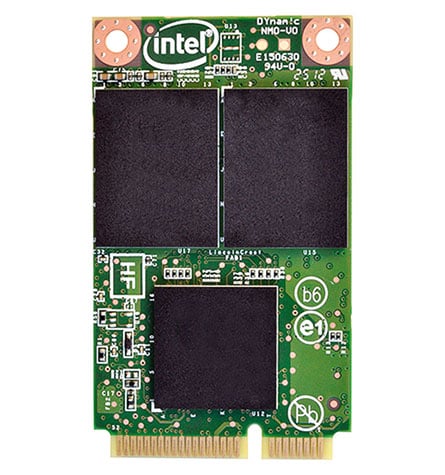It has been quite a while since we last put an mSATA solid state drive
(SSD) under the microscope. It's actually only been about two years, and
if you care to jump into our time machine, you can see what we had to
say about Intel's 310 Series mSATA SSD
in 80GB form. The idea then was the same as it is now -- to offer
full-size SSD features and performance in a smaller form factor that can
wiggle into increasingly thinner Ultrabooks and mini PCs like Intel's Next Unit of Computing
(NUC). Your typical 2.5-inch desktop or notebook SSD measures 7mm or
9.5mm thick and comes housed in a metal or plastic chassis, whereas
mSATA SSDs are much smaller (about one-eighth the size) and run around
naked, traits that allow them to fit into tight spaces and embedded
applications.

Up until recently, consumers haven't had much reason to shop tiny SSDs,
but as mini PCs become more popular, so too will the mSATA form factor.
In the meantime, Intel's forging ahead with mSATA SSD production and
just recently released its 525 Series (Lincoln Crest), essentially a
smaller version of the company's high octane 2.5-inch 520 Series. To
give us an idea of the kind of performance these miniature drives can
pump out, Intel sent us samples of nearly every capacity currently
available: 30GB, 60GB, 120GB, 180GB, and 240GB. The only one we didn't
receive was the 90GB model.
All of these drives feature a SATA 6Gbps interface and specially tweaked SandForce firmware tuned for performance, power consumption, and reliability. Random read performance is rated as high as 50,000 IOPS and sequential reads go up to 550MB/s, while random and sequential write performance metrics are rated up to 80,000 IOPS and 520MB/s, respectively, depending on the specific model.
|
| Maximum sequential read speed up to 550MB/s Maximum sequential write speed up to 520MB/s 25nm NAND flash memory Multi-Level Cell (MLC) SATA 6Gb/s interface TRIM support (OS dependent) Up to 50,000 IOPS (random 4KB reads) Up to 80,000 IOPS (random 4KB write) Thickness: 3.7mm |
Full-sized mSATA form factor Native Command Queuing (NCQ) AES 128-bit encryption MTBF: 1.2 million hours Active power use: 300mW Idle power use: 250mW Warranty: 3 years Shock Resistance: 1,500G (@ 0.5msec half sine wave) O/S Support: Windows XP / Vista / 7 / 8 / Mac OS / Linux |
Intel designed these drives with its NUC in
mind and claims users can expect a minimum useful life of 5 years
assuming up to 20GB of written data per day, or at least 3 year if
writing up to 30GB per day. The MSRPs for these drives are as follows:
- 30GB: $54
- 60GB: $104
- 90GB: $129
- 120GB: $149
- 180GB: $214
- 240GB: $279
Since the NUC is an obvious destination for the 525 Series and we
happen to have one on hand, we used Intel's tiny box to test each of
these drives in a Windows 8 environment. Our goal is to see if Intel can
deliver on its promise to offer big boy performance in a toddler form
factor. We'll get to Intel's report card in a moment, but first, let's
take a closer look at Lincoln Crest.

If you're wondering why Intel chose to outsource the controller to LSI rather than roll its own, it's hard to argue with the claimed performance ratings. The SSD 525 Series isn't just about sheer throughput, though. It also features AES 128-bit encryption, end-to-end data protection that helps protect data from being corrupted by using cyclic redundancy check (CRC) and error correction code (ECC) checks in the data path, and a "Temperature Governor" that protects the drives from overheating to the point of premature failure. Here's more on the latter from Intel:
"The Intel SSD 525 Series drive has a safety feature for monitoring temperature and for protecting the module from overheating, The operating temperature specifications of the Intel SSD 525 Series drive or 0-70 degrees Celsius as measured by the temperature sensor, SMART Attribute BEh," Intel explains. "The drive may occasionally exceed that temperature range and will continue performing, however the Temperature Governor will act to regulate performance to a level that will maintain drive integrity. The host system should be designed to accommodate measures such that normal, typical, operations do not maintain drive temperature outside of specified operating temperature conditions."
We've chosen to highlight this tidbit because Ultrabooks and mini PCs aren't as easy to keep cool as a desktop tower. This is especially true of the NUC, which exhibited stability issues when we reviewed a pre-production version of the device. The integrated Wi-Fi card heats up quickly, and it's placement directly underneath the mSATA port transfers that heat to the SSD in quick fashion. It's good to know that Intel is taking measures to protect mSATA SSDs from burning themselves up should overheating become an issue in these small boxes.

As previously stated, Intel sent us every capacity drive in the 525 Series save for the 90GB model, which doesn't show up in all of Intel's literature but is available to order online. The 30GB drive is the only one that's blue; the 60GB, 120GB, 180GB, and 240GB capacities are all green.
All of these drives are capable of running Windows 8, even the 30GB model. Windows 8 in 32-bit form requires 16GB of disk space and the 64-bit flavor requires 20GB. That doesn't leave much room for third-party apps, but for a basic build for surfing the web and living in the cloud, you can get away with a 30GB SSD. If you're planning to install a bunch of apps, obviously a larger capacity SSD is in order.

Performance varies by model. Shown above is the 240GB model, which boasts up to 550MB/s sequential read and up to 520MB/s sequential write speeds, and up to 50,000 IOPS random 4KB read and up to 80,000 IOPS random 4KB random write speeds. It's not only the largest capacity drive in Intel's 525 Series, it's also one of the fastest, tied with the 180GB in rated specs.
Underneath the sticker are a pair of multi-level cell (MLC) NAND flash memory memory chips built on a 25nm manufacturing process. There are two more NAND flash memory chips on the other side of each SSD, save for the 180GB, which uses three 64GB chips. All of the drives are backwards compatible with SATA 3Gbps.

At just one-eighth the size of regular
2.5-inch SSDs, the mSATA variants measure just 50mm long and 3.5mm
thick, almost small enough to swallow (don't attempt). It's pretty
amazing that such small slices of silicon are capable of the performance
metrics Intel claims. Speaking of which, onto the benchmarks...
We used Intel's NUC to test all the
drives rather than test with the 2.5-inch adapter the company sent us
for the simple reason that mSATA SSDs will end up mini PCs and similar
devices. This did present a unique challenge, however, since the
pre-production NUC I had on hand exhibited some instability. How did we
solve it?
 We began our testing with SiSoftware's
SANDRA, the System ANalyzer, Diagnostic and Reporting Assistant. We ran
four of the built-in subsystem tests that partially comprise the
SANDRA suite (CPU Arithmetic, Multimedia, Memory Bandwidth and Physical
Disk Performance). All of the scores reported below were taken with
the NUC running at its default settings.
We began our testing with SiSoftware's
SANDRA, the System ANalyzer, Diagnostic and Reporting Assistant. We ran
four of the built-in subsystem tests that partially comprise the
SANDRA suite (CPU Arithmetic, Multimedia, Memory Bandwidth and Physical
Disk Performance). All of the scores reported below were taken with
the NUC running at its default settings.

The Intel 525 Series mSATA drives performed right in-line with their specified ratings in the ATTO Disk Benchmark. All of the drives put up good scores, with the higher capacity drives outpacing the smaller models.
EFD Software's HD Tune is described on the company's web site as such: "HD
Tune is a hard disk utility with many functions. It can be used to
measure the drive's performance, scan for errors, check the health
status (S.M.A.R.T.), securely erase all data and much more." The
latest version of the benchmark added temperature statistics and
improved support for SSDs, among a few other updates and fixes.

HD Tune Pro is a little harder on storage systems than your typical synthetic benchmark an measures continued performance over a period of time. All of the averages here are below each drive's rated maximum read speed, and once again, the higher capacity drives performed best.

By getting a little creative (and silly)!
Yes, that's a Cooler Master Hyper 212 Plus CPU cooler, and no, it's not
hooked up to anything. We did, however, rest it on top of the SSDs
during testing to help dissipate the heat generated from our intense
stress testing. Please note you don't actually need to go to this
extreme to use a NUC, but since we didn't experience lockups during
testing, we figured it couldn't hurt.
On a more serious note, we updated the NUC's BIOS to the latest available (GKPPT10H.86A, version 0039 released on March 4, 2013). Other specs include an Intel Core i3 3217-U processor, 4GB of DDR3-1333 SO-DIMM memory, and Windows 8 64-bit.
On a more serious note, we updated the NUC's BIOS to the latest available (GKPPT10H.86A, version 0039 released on March 4, 2013). Other specs include an Intel Core i3 3217-U processor, 4GB of DDR3-1333 SO-DIMM memory, and Windows 8 64-bit.
Benchmarks
|
 30GB Intel 525 |
 60GB Intel 525 |
 120GB Intel 525 |
 180GB Intel 525 |
 240GB Intel 525 |
Intel's 525 Series came out swinging in
Sandra, posting read scores that ranged from 459.6MBs/ (30GB model) to
532.3MB/s (120GB). The three largest capacities (120GB, 180GB, and
240GB) all hovered around 530MB/s, just 20MB/s below their rated maximum
throughput. The 60GB model benched closer to 510MB/s, which is still
impressive. Only the 30GB model is rated at 500MB/s, and it fell just
40MB/s below its theoretical ceiling. So far, so good.
|

The Intel 525 Series mSATA drives performed right in-line with their specified ratings in the ATTO Disk Benchmark. All of the drives put up good scores, with the higher capacity drives outpacing the smaller models.
|

HD Tune Pro is a little harder on storage systems than your typical synthetic benchmark an measures continued performance over a period of time. All of the averages here are below each drive's rated maximum read speed, and once again, the higher capacity drives performed best.
Futuremark's PCMark 7 is the latest version of the PCMark suite,
released last spring. It has updated application performance
measurements targeted for a Windows 7 environment. It combines 25
individual workloads covering storage, computation, image and video
manipulation, Web browsing, and gaming.

Our NUC had trouble with the latest version of PCMark 7 (version 1.4.0) and refused to spit out a "Computation score," which played havoc with the overall score. In light of this, we decided to limit testing to the "System storage" portion of the test since we're focusing on SSD performance.
Things were pretty balanced with not much separation between the lowest performing drive (30GB, 4,790) and the highest performing drive (60GB, 5,146).
CrystalDiskMark is a synthetic benchmark
that tests both sequential and random small and mid-sized file transfers
using incompressible data. It provides a quick look at best and worst
case scenarios with regard to SSD performance, best case being larger
sequential transfers and worse case being small, random transfers.
What's interesting about our CrystalDiskMark testing is that sequential
performance steadily improved each time we popped in a higher capacity
SSD into the NUC. This was true for both read and write metrics. Things
were a bit more even keel during the 4K portion of the test.
|

Our NUC had trouble with the latest version of PCMark 7 (version 1.4.0) and refused to spit out a "Computation score," which played havoc with the overall score. In light of this, we decided to limit testing to the "System storage" portion of the test since we're focusing on SSD performance.
Things were pretty balanced with not much separation between the lowest performing drive (30GB, 4,790) and the highest performing drive (60GB, 5,146).
|
 180GB Intel 525
180GB Intel 525 |
 240GB Intel 525 |
Performance Summary:
Intel's SSD 525 Series mSATA drives worked as advertised, and that's no
small feat considering Intel is promoting "great performance" in a
package that's a fraction of the size of a 2.5-inch SSD. All five
capacities we tested -- 30GB, 60GB, 120GB, 180GB, and 240GB -- turned in
fast synthetic benchmark results across the board, which translated
into speedy real-world performance. To give a specific example, the
three larger capacity drives each scored around 530MB/s to 532MB/s in
SiSoft Sandra, which is in line with Samsung's 2.5-inch 840 Series.
 Intel's 525 Series SSDs come in capacities ranging from 30GB to 240GB.
Intel's 525 Series SSDs come in capacities ranging from 30GB to 240GB.

Oftentimes in technology there are concessions made at every turn. Trying to build a quiet system? You're probably going to have to sacrifice ultra high-end components to do so, or pay a premium on advanced cooling techniques. Need an ultra-compact laptop that's thin and light? Say goodbye to the optical drive. There are countless examples, but every once awhile, a hardware maker defies the status quo and simply builds a better product. This is one of those instances.
Conventional wisdom might say that if you're going to shrink the SSD, something has to give, and it's probably performance. That's not the case here. Intel's SSD 525 Series offers blazing fast performance in an mSATA form factor that can fit into tight spaces, such as Ultrabooks, mini PCs, and embedded applications. We saw read speeds top 550MB/s in some instances with write speeds not far behind. It doesn't get much faster, not unless you're willing to stick a pair of drives in a RAID 0 configuration.
The weakest link in the 525 Series is the 30GB model, both in terms of available capacity and rated performance, especially write performance, which is rated at 275MB/s (sequential). It's still a peppy drive, just not as fast as its larger capacity siblings, and obviously you're limited to the number of applications you can fit on a 30GB drive.
For all the positives, there are a couple of reasons why users might skip over the 525 Series. The first is price. Intel's MSRPs are above $1 per gigabyte at a time when high performing 2.5-inch drives have dipped below that point. And the second reason is application. Unless you're rocking a NUC or other device that can accept an mSATA drive, the 525 Series won't do you any good. That's where Intel's 520 Series comes into play. It's essentially the same drive, but in a 2.5-inch form factor.
The inability for consumers to find a home for an mSATA SSD might be a short lived limitation. As technology trends towards smaller form factors, expect to see mini PCs like the NUC take center stage. When that day comes, it's good to know there are fast mSATA SSDs already on the market.

FROM : http://hothardware.com
 Intel's 525 Series SSDs come in capacities ranging from 30GB to 240GB.
Intel's 525 Series SSDs come in capacities ranging from 30GB to 240GB.Oftentimes in technology there are concessions made at every turn. Trying to build a quiet system? You're probably going to have to sacrifice ultra high-end components to do so, or pay a premium on advanced cooling techniques. Need an ultra-compact laptop that's thin and light? Say goodbye to the optical drive. There are countless examples, but every once awhile, a hardware maker defies the status quo and simply builds a better product. This is one of those instances.
Conventional wisdom might say that if you're going to shrink the SSD, something has to give, and it's probably performance. That's not the case here. Intel's SSD 525 Series offers blazing fast performance in an mSATA form factor that can fit into tight spaces, such as Ultrabooks, mini PCs, and embedded applications. We saw read speeds top 550MB/s in some instances with write speeds not far behind. It doesn't get much faster, not unless you're willing to stick a pair of drives in a RAID 0 configuration.
The weakest link in the 525 Series is the 30GB model, both in terms of available capacity and rated performance, especially write performance, which is rated at 275MB/s (sequential). It's still a peppy drive, just not as fast as its larger capacity siblings, and obviously you're limited to the number of applications you can fit on a 30GB drive.
For all the positives, there are a couple of reasons why users might skip over the 525 Series. The first is price. Intel's MSRPs are above $1 per gigabyte at a time when high performing 2.5-inch drives have dipped below that point. And the second reason is application. Unless you're rocking a NUC or other device that can accept an mSATA drive, the 525 Series won't do you any good. That's where Intel's 520 Series comes into play. It's essentially the same drive, but in a 2.5-inch form factor.
The inability for consumers to find a home for an mSATA SSD might be a short lived limitation. As technology trends towards smaller form factors, expect to see mini PCs like the NUC take center stage. When that day comes, it's good to know there are fast mSATA SSDs already on the market.

|
|
|
|
|





Tidak ada komentar:
Posting Komentar